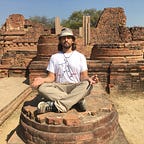This is Why Zen Meditation Will Make You More Zen
Zen Buddhism originated in China in the 5th century and is a mix of Taoism and Indian Mahayana Buddhism. It has since spread across Asia and recently to the West.
The word zen merely means “meditative state,” and Zen Buddhists emphasize direct understanding of the mind and reality through spiritual practices rather than through religious texts or doctrines.
To reach this deeper understanding beyond words and intellectual knowledge, 3-pronged meditation practice was developed. In this blog, I will explain the types of zen meditation, the benefits, and how you can get started.
What are the 3 Types of Zen Meditation?
In Zen meditation, there is no goal to achieve. The meditation practice itself is the goal.
There is no reward or enlightenment to grasp, we just let go of all expectations and do the practice for the sake of doing the practice.
In this way, the practice becomes its own reward. The longing and craving for some end result do not become an impediment or disturbance on the path to enlightenment.
The Posture
To get started, much like any other meditation practice, we sit on the floor if that is possible or a chair if it is not. On the floor, sit with a cushion under your butt and cross your legs in the lotus or half-lotus position (Indian style).
Sit with your back, neck, and head straight and erect with your chin pulled in slightly. Don’t sit too tense or too relaxed. Try to find the sweet spot in the middle.
Concentration
This is the first type of meditation any zen student will practice. Before moving on to various other types of meditation that clear the mind of all thoughts, a student must first be able to concentrate on a single thought or object.
Developing the power of concentration can be done in a variety of ways. Most often, this involves focusing on the sensations of the breath by observing the belly expanding and contracting.
Koan Contemplation
Once you have mastered the ability to focus and concentrate, the next step is to focus on an unsolvable riddle. Most famously being, “What is the sound of one hand clapping?”
There is no answer to discover, nothing to figure out, no solution to be had. All the reasoning in the world will not help you get to the answer.
These types of koans force the meditator to short-circuit their thinking mind and sit in stillness, allowing for the koan to enter them on a deeper level than just the surface of the mind. This is where true wisdom resides.
Originally published on www.EastWesticism.org
Let me take YOU on a spiritual journey, from Aloneness to Oneness, where borders and barriers disappear, and open hearts and open minds take hold. It takes us to a place where anger, greed, hatred and fear cease to be, and only love, joy, peace and gratitude remain.
Watch Full Video https://youtu.be/9M56t0UoW5M
